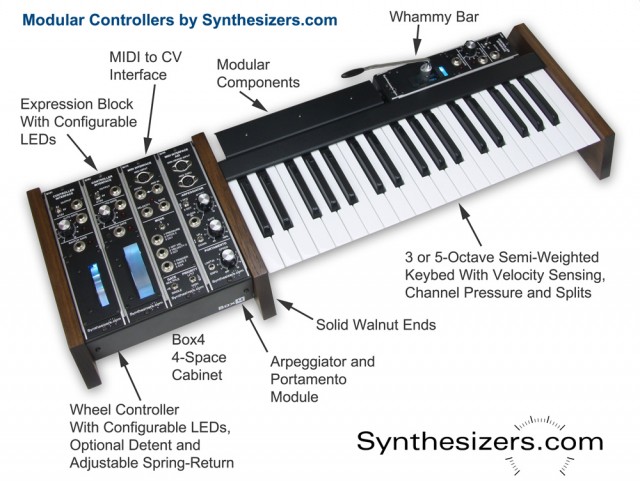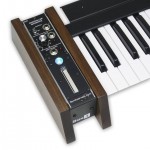Synthesizers.com has been teasing out information on a new line of modular control keyboards for modular synthesizers.
In a post on Facebook, Synthesizers.com’s Roger Arrick asks:
What if controllers were modular too?
Then we could treat controllers just like the modular system itself.
Move things around as needed, build up a completely custom rig that suits our own purposes. For example, what if we could add a wheel controller to any side of the keyboard, as many as we wanted?
Here are some examples of how you can customize the controller:
Pricing and availability for the Synthesizers.com modular controller system is to come, but Arrick expects to start shipping some of the modules in Jan.
Check it out and let us know what you think of it!
via Roger Arrick, matrixsynth








Looks like fun! Now if only I could play properly… . . . 🙂
Love the idea, but I’m wondering about the price….
Its great to see someone actually implement an old request: customizable controllers. I don’t think the price is going to daunt many modular users. Its an expensive hobby, so you either have the cash to spare or you are insane and will find a way, regardless, sometimes both!
I’d love to see this be possible with some of the recent great synths that have had superior innards but shoddy keyboards. Overall, most users seem somewhat like me: they sweat blood for a couple of central, more costly pieces, then add peripherals on a sliding scale. I think these will sell well. If you’re totally into joysticks, being able to replace the pitch/mod wheels is a mighty leap ahead in fluid, fun-time playing.
Problem is that modular-freaks are the least classically trained. They like to play with wires instead of keyboards, making robot farts out of walls of modules.
Though the price point is a consideration.
With all of the near-black-magic advances, there is a hazy line between “real” playing and mere sequence triggering. I enjoy many of the modular soundscapes or interlocking percussion blowouts I hear, but I have to listen with a different ear than the one I use for blues or classical. The TERMS are different. The clever cut-&-paste of a Live dubstep fan is very different from the more hand-rendered things I do in Logic. The collaboration between the user and the designers’ idea of What Works is so abstract in a couple of key ways that its hard to discuss in clear terms. I once had a friend who did a college radio show of all-abstract material he called “the music of sound rather than just the sound of music.” If you expected rock, you got a big let-down. If you wanted to be challenged with Pauline Oliveros, algorithmic musics or seriously processed sound of all kinds, you were on target.
So its not a matter of how useful or expensive the gear is. Its about how successful a modular player is in getting across to the listeners and that’s the same thing every musician faces. The Council of Cats has unanimously agreed that they all hate heavy metal suddenly played at 135 db in the den. Know your audience, including how to win them over to your side.
It is surprising to see such an uninformed comment about electronic music on a site like Synthtopia.
Anyone with knowledge of electronic music should know about the history of modular synthesizers in the world of electroacoustic music – part of the classical music tradition. Check outMorton Subotnick when you have a chance!
the vast majority of people i know personally who collect and use modulars regularly are not classically trained and barely know the difference between the white keys and the black keys. that doesn’t stop them from making music they enjoy..and engaging in music and sound design.
but from my perspective i don’t think it’s necessarily an uninformed comment to make.
Cables should be active components.
Each cable has its own “amount” as a pot at one end.
Instead of having a single dumb plughole and a separate “amount” pot for eg FM Input,
you stack any number of cables (like Buchla bananas).
I’ve implemented this in code (but not released as a product), to me it’s great.
You can morph freely between patches.
The second step in code is that the pot amount is also a control input point, so you could use LFO or the sequencer to switch/morph between any number of patches.
In hardware, the second step is to have bluetooth/wifi control over the cable “amount” pots,
then you could remote control modular synth patches of existing hardware.
Figured this out some time ago, if someone has soldering capability and is interested, the idea is for free, we could connect afk. I’m not sure what the parts cost would be.
They offer combinations, i like that. Thats a generous to go for a company..
As someone mentioned, an age-old idea to have a custom-modular controller. At least someone is doing this! I think a company/start-up needs sufficient clout to make it sustainable/popular or back to regular synths/”modular” modular we go.
The Facebook post & comment section read just like a late night infomercial.
I definitely would buy this – even if it just gives more scope to my “synthesizer farts”
Synthesists performance/programming and the art of mastering piano and/or organ technics are two differant artistic concepts. While it is true that keyboardist have an easier time migrating to synthesizers and performing some intersting tricks. the art of synthesist is much more than that. In short sound creation, manipulation and sonic control is much more than physical performance, harmony and melody. I entirely welcome any technology that furthers the art of creating sounds, makeing the sounds musical and instruments that allow you to best explore and perform the thoughts and feelings in your heart, mind and soul. The concept sounds great for synthesists, I only pray that it is affordable and not some ‘jacked up’ price because of the demand